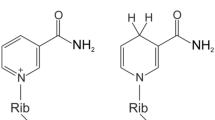Abstract
• Background: 3-Hydroxykynurenine, a metabolite of tryptophan, acts as UV filter in the human lens. In this study, we looked for this substance and its metabolites in young and old bovine lenses, because of their possible role in the formation of cataract. • Methods: The substances were detected by HPLC analysis. The fluorescent substance formed from 3-hydroxykynurenine was characterized by thin-layer chromatography followed by reaction with ninhydrin, UV and fluorescence spectrum analysis, and atom bombardment for molecular mass determination. The kynurenine aminotransferase activity was determined by the method of Tobes. • Results: 3-Hydroxykynurenine was detected at concentrations of 0.07, 0.19, and 1.14 μg/g of tissue in the bovine iris/ciliary body, retina, and transparent bovine lenses respectively. 3-Hydroxykynurenine was deaminated in old bovine eyes but not in calf eyes. In old eyes, kynurenine aminotransferase activity was 2.7, 3.5, and 9.6 μmol/g of tissue per h in retina, iris/ciliary body, and lens respectively. • Conclusion: The deamination of 3-hydroxykynurenine resulted in the formation of a fluorescent substance which was identified as oxidized xanthurenic acid. This substance, accumulating in the bovine lens and interacting with lens proteins, could induce cataract formation.
Similar content being viewed by others
References
Bessems GJH, Keizer E, Wallensak J, Hoenders HJ (1987) Non-tryptophan fluorescence of crystallins from normal and cataractous lenses. Invest Ophthalmol Vis Sci 28:1157–1163
Borkman RF, Tassin JD, Lerman S (1981) The rates of photodestruction of tryptophan residues in human and bovine ocular lens proteins. Exp Eye Res 32:747–754
Christen S, Peterhans E, Stocker R (1990) Antioxidant activities of some tryptophan metabolites: possible implication of inflammatory diseases. Proc Natl Acad Sci USA 87:2506–2510
Dillon J (1980) The anaerobic photolysis of tryptophan-containing peptides. Photochem Photobiol 32:37–39
Garcia-Castineiras S, Dillon J, Spector A (1978) Non-tryptophan fluorescence associated with human lens protein: apparent complexity and isolation of bityrosine and anthranilic acid. Exp Eye Res 26:461–476
Harding JJ (1991) Radiation cataract. In: Harding JJ (ed) Cataract. Biochemistry, epidemiology and pharmacology. Chapman and Hall, London, pp 147–155
Harding JJ, Crabe MJC (1984) The lens: development, proteins, metabolism and cataract. In: Davson H (ed) The eye, vol IB. Academic Press, London, pp 207–492
Heyningen R van (1971) Fluorescent glucoside in the human lens. Nature 230:393–394
Heyningen R van (1973) Photo-oxidation of lens proteins by sunlight in the presence of fluorescent derivatives of kynurenine, isolated from the human lens. Exp Eye Res17:137–147
Heyningen R van (1973) Assay of the fluorescent glucosides in the human lens. Exp Eye Res 15:121–126
Horowitz J (1992) α-Crystallin can function as a molecular chaperone. Proc Natl Acad Sci USA 89:10449–10453
Ichijima H, Iwata S (1987) Changes of lens crystallins photosensitized with tryptophan metabolites. Ophthalmic Res 19:157–163
Krishna CM, Uppuluri S, Riesz P, Zigler Jr JS, Balasubramanian D (1991) The study of the photodynamic efficiencies of some eye lens constituents. Photochem Photobiol 54:1–8
Kurzel BR, Wolbarsht M, Yamanashi BS, Staton G W, Borkman RF (1973) Tryptophan excited states and cataracts in the human lens. Nature 241:132–133
Lerman S, Borkman R (1976) Spectroscopic evaluation and classification of normal, aging, and cataractous lens. Ophthalmic Res 8:335–353
Lerman S, Borkman R (1978) Photoacoustic, fluorescence and light transmission spectra of normal, aging, and cataractous lenses. Ophthalmic Res 10:168–176
Luthra M, Balasubramanian D (1992) 3-Hydroxykynurenine and 3-hydroxyanthranilic acid may act as endogenous antioxidant in the eye lens. Exp Eye Res 55:641–643
Malina HZ, Martin XD (1993) Indoleamine 2,3-dioxygenase activity in aqueous humor, iris/ciliary body, and retina of bovine eye. Graefe's Arch Clin Exp Ophthalmol 231:482–486
Malina HZ, Martin XD (1993) Activity of indoleamine 2,3-dioxygenase in human lens. Invest Ophthalmol Vis Sci 34 [Suppl]: 291
Martin XD, Malina HZ (1993) Indoleamine 2,3-dioxygenase activity in human iris/ciliary body and retina. Invest Ophthalmol Vis Sci 34 [Suppl]: 1284
Martin XD, Brennan MC, Lichter PR (1988) Serotonin in human aqueous humor. Ophthalmology 95:1221–1226
Ohnishi T, Hirata F, Hayaishi O (1977) Indoleamine 2,3-dioxygenase. Potassium superoxide as substrate. J Biol Chem 252:4643–4647
Satoh K, Bando M, Nakajima A (1973) Fluorescence in human lens. Exp Eye Res 16:167–172
Stutchbury GM, Truscott RJW (1993) The modification of proteins by 3-hydroxykynurenine. Exp Eye Res 57:149–155
Tobes MC (1987) Kynurenine-oxoglutarate aminotransferase from rat kidney. Methods Enzymol 142:217–224
Tomoda A, Yoneyama Y, Yamaguchi T, Shirao E, Kawasaki K (1990) Mechanism of coloration of human lenses induced by near-ultraviolet-photo-oxidized 3-hydroxykynurenine. Ophthalmic Res 22:152–159
Truscott RJW, Martin F (1989) The reaction of proteins with 3-hydroxyanthranilic acid as a possible model for senile nuclear cataract in man. Exp Eye Res 49:927–940
Truscott RJW, Faull K, Augusteyn RC (1977) The identification of anthranilic acid in proteolytic digest of cataractous lens proteins. Ophthalmic Res 9:263–268
Truscott RJW, Carver JA, Thorpe A, Douglas RH (1992) Identification of 3-hydroxykynurenine as the lens pigment in the gourami Trichogaster trichopterus. Exp Eye Res 54:1015–1017
Wood AM, Truscott RJ (1993) UV filters in human lenses: tryptophan catabolism. Exp Eye Res 56:317–325
Yamazaki F, Kuroiwa T, Takikawa O, Kido R (1985) Human indolylamine 2,3-dioxygenase. Its tissue distribution and characterization of placental enzyme. Biochem J 230:635–638
Yu NT, Cai MZ, Ho DJ, Kuck JFR (1988) Automated laser scanning-microbeam fluorescence/Raman image analysis of human lens with multi-channel detection: evidence for metabolic production of a green fluorophor. Proc Natl Acad Sci USA 85:103–106
Zigman S (1971) Eye lens color: formation and function. Science 171:807–809
Zigman S, Paxhia T (1988) The nature and properties of squirrel lens yellow pigment. Exp Eye Res 47:819–824
Zigman S, Groff J, Yulo T (1977) Enhancement of the non-tryptophan fluorescence of human lens proteins after near-UV light exposure. Photochem Photobiol 26:505–509
Zigman S, Paxhia T, McDaniel T, Lou ME, Yu NT (1991) Effect of chronic near-ultraviolet radiation on the gray squirrel lens in vivo. Invest Ophthalmol Vis Sci 32:1723–1732
Author information
Authors and Affiliations
Rights and permissions
About this article
Cite this article
Malina, H.Z., Martin, X.D. Deamination of 3-hydroxykynurenine in bovine lenses: a possible mechanism of cataract formation in general. Graefe's Arch Clin Exp Ophthalmol 233, 38–44 (1995). https://doi.org/10.1007/BF00177784
Received:
Revised:
Accepted:
Issue Date:
DOI: https://doi.org/10.1007/BF00177784




